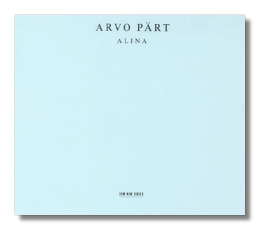
The Internet's Premier Classical Music Source
Related Links
- Pärt Reviews
- Latest Reviews
- More Reviews
-
By Composer
-
Collections
DVD & Blu-ray
Books
Concert Reviews
Articles/Interviews
Software
Audio
Search Amazon
Recommended Links
Site News
 CD Review
CD Review
Arvo Pärt

Alina
- Spiegel im Spiegel (three versions)
- Für Alina (two versions)
Vladimir Spivakov, violin
Dietmar Schwalke, cello
Alexander Malter & Sergej Bezrodny, piano
ECM New Series 1591 (449958-2) DDD 51:21
The foundation of this CD is less than fifteen minutes of music; those who fail to admire Arvo Pärt's music will be even less generous than that. Speigel im Spiegel was written in 1978, and Für Alina was written two years earlier. These works are very early examples of Pärt's current style of composition, which he refers to as "tintinnabuli" – an allusion to bells and their tolling, triadic melodies. Elsewhere, Pärt has said "it is enough when a single note is beautifully played," and that attitude is at the heart of Spiegel im Spiegel and Für Alina. In essence, this is minimalist music, although Pärt might not embrace the term. Listener acceptance has been facilitated by the music's apparently spiritual qualities. These, however, have more to do with the composer's extramusical commentary than with anything specific to the notes; one could argue that all music is spiritual. Critic Mark Swed wrote that Für Alina "falls somewhere between the character of a minimalist Bach chorale and a lullaby." That description might also apply to Spiegel im Spiegel. Neither raises its voice above a devout whisper.
So, to return to this review's opening sentence, part of what this disc offers is three performances of Spiegel im Spiegel two for violin and piano (the original scoring, I believe, because Spivakov was the work's dedicatee) and one for cello and piano. I can discern very few differences between the three, except for obvious differences in string timbre and timing the shortest version requires 9:12 and the longest requires 10:36. Spivakov and Schwalke play their parts with the requisite fragility, and Bezrodny (with Spivakov) and Malter (with Schwalke) support their partners with softly sounded arpeggios and delicate emphases. The other part of this disc is two performances of Für Alina. One might argue, however, that more than two are offered here. The work, as published, is probably only about two or three minutes long. I say "probably" because Pärt allows the performer to determine meter and tempo; the markings at the head of the score are "calm," "exalted," and "listening to one's inner self." These directions (or lack thereof) have encouraged pianist Malter (apparently with the composer's blessing) to take an improvisational approach to Für Alina. Malter listens to his inner self, and then listens again and again. The result is a "block" of Für Alina that lasts for 10:47, and a second block that lasts for 10:53. Again, there are no gross differences between these two versions, just as there are no gross contrasts within the piece itself. Notewise, the performers on this CD do not have a challenging task, but "a single note… beautifully played" is hard to come by, and that is the interpretive challenge that is met and solved wonderfully on this CD. This release, though, begs some questions. If two or three versions of the same piece are good, why not five or six, or eight or nine? What is the benefit that the listener receives? And, more to the point, how would ECM answer accusations of providing poor value to the consumer? Can it rely on his or her indulgence or spiritual receptivity, or will there be comments about the emperor and his new clothes? The vague and rather pretentious booklet notes up the mystification quotient. Great sound, great production values, a great opportunity to listen… but also a great vulnerability. There's something touching about that.
Copyright © 2000, Raymond Tuttle




















